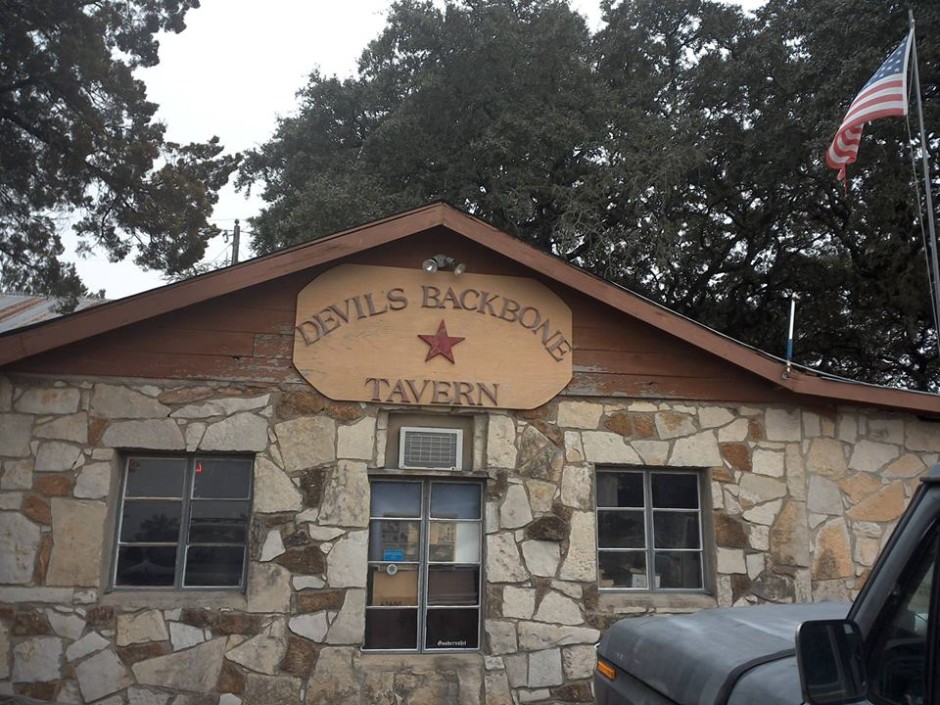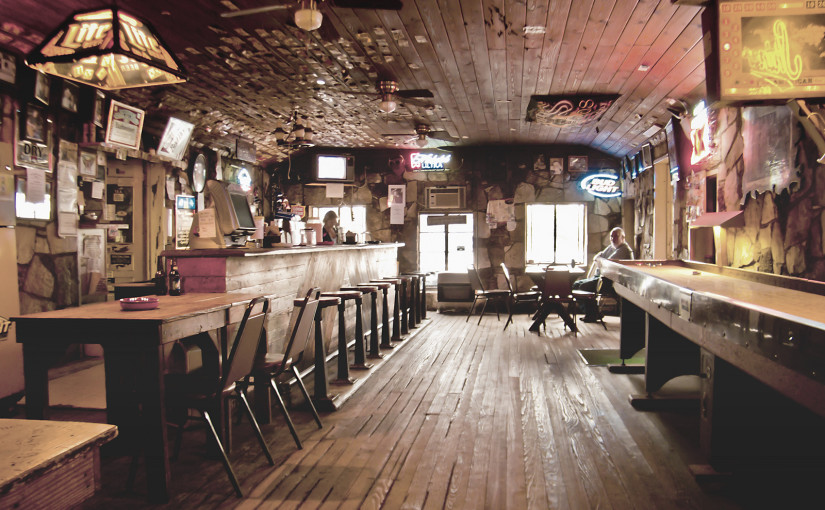This is a story I wrote for The Daily Texan in like 2003. I still try to swing by the ’Bone a couple of times a year.
If you happen to run your finger over a bullet hole in the wall of the Devil’s Backbone Tavern, don’t worry—it’s just a remnant of rowdier days.
Most of the old-timers who shot up the walls and ceiling of the small rock structure are dead and gone, and the ones still around say they are now too old to bother. Instead, they sit back and drink their Milwaukee’s Best Light, the cheapest beer in the house, and tell stories that mingle legend with history.
For instance, the place is haunted. Always has been.
“Oh, there are ghosts, I guaran-goddamn-tee you,” said Robert Kelly, a regular who said he sometimes sees shadowy figures on a steep nearby ridge called the Devil’s Backbone, for which the tavern is named.
Brushes with the paranormal are to be expected in a place like this, where the face of the Devil himself is manifest in a rock mortared into the stonework above the fireplace at the back wall.
In fact, many claim the Backbone—the ridge and the tavern—is the most-haunted spot in the state.Amanda Joan Couve, a bartender who studies sociology at Southwest Texas State University, has had her share of run-ins with the ghost. He tends to stick to the south end of the place, rearranging furniture, turning off lights and causing all-around mayhem, said Couve. On summer nights when the air is still as death, the door that leads to the adjoining dance hall inexplicably slams to and fro. Other nights, before they went ahead and tied it to the wall, the box fan fell to the floor whenever Couve walked nearby.
“It was weird,” she said. “It was like the ghost was mad at me or something.”
Couve thinks the tavern is haunted by a man shot dead as he walked into the bar years ago, when the place was rowdier. But the older folk, who remember those lawless days, tend to agree it’s a Native American killed in some ancient and forgotten Indian battle. Still others say their spooked friends are full of it.
“My daddy, my grandpa and my great-grandpa lived around here, and we never saw anything,” said Floyd Fischer, who spends most afternoons at the table by the window, swapping stories and sipping on a cold beer.
At 62, he’s frequented the tavern for decades, as his father did before him. He grew up along the Backbone, trapping ringtails that fetched $50 at a time when a full day’s labor could bring in as little as a dollar a day.
Today, he lives in a little ranching community on the other side of the ridge named for his ancestors, the Fischers, German immigrants who settled the area in the 1850s. He maintains a spread of land passed down through the generations, and his cousins still populate the area. In short, Fischer is one of the old-timers.
Fischer distinguishes between several different types of folks at the Devil’s Backbone Tavern. You’ve got your old-timers, the people who grew up around the ridge; college kids driving in from San Marcos; bikers; and the newcomers.
First, there are the guys with the Harleys, who in recent years have begun frequenting the place on nights and weekends: “We’re overrun by bikers, but they’re all good people now,” he said. “When I grew up in this country, they rode the old Indian bikes. Now those were bad people.”

Back in those days, if you saw a bike parked in front of the tavern, you didn’t stop. But now the bikers are mostly doctors and lawyers, a fine sort, he said.
Then there are the newcomers.
They’re the folks who made their money at big-city jobs and then retired to places like Wimberley – where you don’t ask people where they’re from, but what part of Houston they’re from – or they live out on Canyon Lake and commute to Austin and San Antonio.
Pretty much anybody who has moved into the area within the past two or three decades is considered a newcomer, it seems. The winding road to the tavern from Wimberley is dotted by billboards advertising Hill Country land for sale, and people continue to take up the offers in droves.
Development is driving up the cost of land in the area, and Fischer said ignorance on the part of the newcomers has transformed the landscape of the region and has even led to an invasion of coyotes.
“In the old days, my daddy and relatives wiped the coyotes out of this country, or you couldn’t raise sheep and goats and make a living,” he said. “They were gone the whole time I grew up in this country, until I retired. Things got populated, and nobody would cut the cedar or do anything, so, hell, they had all the cover they needed.”
While the coyotes move in, the old-timers’ children continue to move off. Fischer said most have to leave to find a living wage.
“There’s no jobs around here unless you work in the bar or at a convenience store,” he said. “I don’t know what else there is to do but drive a school bus or something.”
Fischer’s only daughter, now 38, found work in Austin and later in San Antonio.
“It was the same way when I grew up,” he said. “When I got out of the military, I said, ‘What am I gonna do? Go back to cutting cedar or shearing sheep and goats?’ No. I went to state work and retired from there, so I can get a pension and all that.”
He worked for the state in San Antonio for 30 years, coming back on the weekends to help the family. When he retired, he moved back for good.
Now he shares his table at the Devil’s Backbone Tavern with all classes of people, rubbing elbows with developers and retirees. They claim to be a little more laid back than the people who haunted the tavern in its early years.
The tavern sits near the tail of the Devil’s Backbone, a narrow, winding ridge in northeastern Comal County that tears through two river basins, the Blanco and the Guadalupe. The ridge, wide enough for a two-lane ranch road and a little shoulder, for years was the vein of commerce between San Marcos and the town of Blanco.
Built in 1932 on the site of an old blacksmith’s shop, the tavern had originally been a stop at the base of a treacherous stagecoach trail.
People from Hays County, which was dry, began flooding the tavern on the edge of Comal County—the only place for miles where a person could get a beer. Johnny Jenkins, 59, remembers growing up in nearby Wimberley. He and his friends would hang out in the parking lot trying to convince patrons to buy them a few beers, and they succeeded more often than not, he said.
These days, Jenkins is welcome inside the establishment. He meets up with his friend from San Marcos, Rusty O’Bryant, the retired owner of a plumbing supply store who donated the trough in the men’s restroom.
They usually play shuffleboard, another holdover from the rough-and-tumble early days, but lately their opponents have stopped coming by. So instead, Jenkins and O’Bryant sit at a back table drinking Milwaukee’s Best.
“I’m retired, and it gets boring at home,” Jenkins said.
Currently, Jenkins and O’Bryant are mad at one of the bartenders, so they time their visits to coincide with Couve’s work schedule.
But even in the midst of their bartender boycott, they know things will not escalate to the point where pistols are drawn.
“Once in a while we get pissed off at one another and raise hell, but that doesn’t last more than a day or two,” O’Bryant said. “We’re too old to fight.”
This story was originally published Aug. 12, 2003, in The Daily Texan, the student newspaper at The University of Texas at Austin. The featured image is courtesy of Flickr user yep.photo.

3,905 responses to “Legend of the Devil’s Backbone Tavern”
This playlist is a mood lifter! Each song flows seamlessly, creating a perfect ambiance. Thanks for the musical journey.
I just added this website to my feed reader, excellent stuff. Can not get enough!
I appreciate the research you put into this. It makes your points even more compelling
This was such a helpful read. I’ll definitely be referring back to it in the future
Its like you learn my mind! You seem to understand so much approximately this, like you wrote the book in it or something. I feel that you can do with a few percent to force the message home a little bit, but instead of that, this is great blog. A great read. I’ll certainly be back.